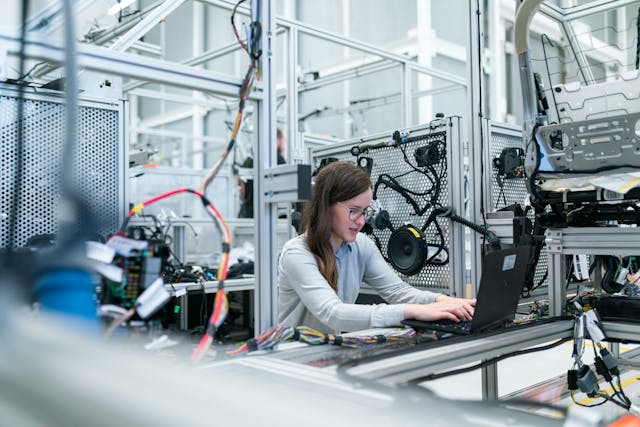Retrieval Augmented Generation
Retrieval augmented generation or RAG is a technical architectural approach to improve the output generated by LLMs or large language models. By retrieving information from external knowledge bases and data sources, RAG allows generative systems to maintain their output information and improve the accuracy of responses.
Through RAG, enterprises can also highly customize their generative AI systems and tools. RAG architectures can help maintain up to date information, while enabling systems to access domain-specific knowledge libraries.
It's important to understand how the two types of RAGs operate, namely RAG-Sequence Model and RAG-Token Model. Both can be leveraged in unique instances to help enterprises enhance their generative AI systems and solutions.
Definition of Retrieval Augmented Generation (RAG)
It is important to start with the core definition of RAG so that enterprises can understand its applications and use-cases better. RAG allows for the analysing of external knowledge bases or data sources to provide responses and answers to queries that enable generative AI tools to access LLMs and external sources.
While the vector database stores the information in the form of numerical representations, the retrieval augmented generation work to enhance the accuracy and meaning of each response. Enterprises can improve their tools significantly by leveraging the right RAG model. There is limited need for retraining the model and accessing different data sources to consistently updating information.
Evolution of retrieval-based models in NLP
The genesis of NLP or natural language processing in the 1960s has led to the innovative NLP RAG AI systems that we see today. Key advancements in sequence-to-sequence modelling made it possible to perform a range of advanced tasks that we are able to explore in the modern era.
The overall advancements in semantic search, language transformers, and extractive understanding have also made RAG and NLP more utility based. Enterprises are able to create novel applications that can help internal employees learn and provide information to customers across domains. Market research, trends detection, and documentation analyses are other evolutions of the RAG model pertaining to enterprise use.
It is also vital to explore the limitations of standalone retrieve and generative models, as they may not be able to provide the correct response for more complex queries in some instances. E.g., employees undergoing training may not gain the complete perspective when querying for multi-layered tasks. The LLM may not know the answer to - "How many parts are required for a specific engine for a commercial automobile for this year's production?"

Key Components of RAG
RAG bridges the gap between retrieval and generative models, by allowing for external data access, analysis, and processing. Enterprises can understand the different components of RAG to enable comprehensive utility and adoption.
Retrieval - The retrieval aspect of RAG focuses on locating and obtaining the semantic meaning and similarity of text from external sources. These can also include other forms of information, which can be gathered using neural network based retrieval.
Augmentation - Augmentation focuses on enhancing the context and accuracy of the information being generated when it comes to the foundational model and the input query. Augmentation is critical to add more context to the input and provide insight to the user asking the query.
Generation - The generation of the answer to the query is a vital stage as well. Template based generation, statistical language models, and neural network based generation can be used to provide the appropriate answer.
Challenges that RAG solves
There are several challenges that RAG solves, which is why it is adopted across enterprises for highly specific use-cases. By understanding the core solution areas for RAG, enterprises can improve their generative AI tools and applications while ensuring accuracy of generated responses.
-Updating information for prompts
Vector databases can leverage up to date information using generative solutions. By connecting static LLMs with real-time data retrieval, RAG can make gen tools more effective for various knowledge intensive tasks. While the genAI leverages its vector database and natural language processing, RAG can make it more updated using its architecture.
-Customizing and personalizing generated data
For AI to be effective in providing the right answers to queries and tasks, it needs to leverage customized data provided by the enterprise itself. This can make the large language models more updated with relevant information, by accessing external knowledge and relevant documents.
-Lesser need of retraining data
There is a lower need of retraining data when using generative AI for such knowledge intensive tasks. The updating of the large language model with the right retrieve relevant information to update the knowledge library is optimized using RAG.
-Lowering cost of running LLM tools
By updating the information retrieval component of the tool being leveraged, RAG can essentially lower the computational and financial costs of running multiple generative tools. The parameterized knowledge can also be updated quicker when leveraging RAG and its associated features.
-Reducing unpredictability of responses
Another key challenge that RAG systems optimize through their architecture is the reduction of unpredictability. RAG solutions ensure that there is minimal randomness in their responses, and that variables are pulled from reliable and highly precise resources. This can help in reducing the need for updating the training data, while maintaining accuracy.

Architecture overview of RAG
Since RAG is designed to pull data from external sources, it is important to know how it does so through its architecture. The external data itself can come from multiple types of sources, making it that much more complex to gauge its process flow.
The external data can come from repositories, internal data sets, APIs, and other sources, which would have to be converted into a compatible format. This can help in embedding the data into the large language model, through numerical representations. These representations can be used to generate responses that are more accurate and related to the query asked.
The knowledge base or knowledge library is itself converted into a numerical representation through a vector space model. The embeddings of the user query are then compared and matched with the vector of the knowledge library to produce the final answer for the query input. More context is also then added through the analysis of similar documentation from within the knowledge base.
The final augmented prompt is sent to the foundation model, after which a range of analyses are performed to provide greater context and capture more accurate data. RAG LLM is then updated with the relevant information and embeddings to provide a final answer that is relevant to the query. The most relevant documents and information is used to construct a new prompt with additional context.
Major applications of RAG
The combination of deep learning methodologies with intricate natural language processing, allow for a range of applications that can help enterprises in multifaceted ways. Let us explore some of the major applications of the retrieval augmented generation RAG technology.
-Market research
Within the market research sphere, customer data can be made more contextual and accurate by extracting insights from different research documents and private enterprise data. This can help enterprises make more meaningful customer decisions, based on price trends, preferences, product adoption rates, reselling, sales, etc. along with the market research data collected.
-Forecasting
Similar to how enterprises can perform market research using RAG, forecasting is another interest area of exploration. Enterprises can create RAG models that are designed to extract utility based information from multiple predefined but actively updated sources. This can help generate forecasts in agricultural domains, finance and technical solutions, as well as supply chain movement and fleet tracking.
-Documentation review
Legal, healthcare, and technical industries can improve their research & development, sales, and marketing insights with RAG LLM documentation reviewing. The RAG AI can leverage the comprehensive RAG architecture to provide retrieval-augmented generation based on specific prompts. These prompts can include drug design references, patient protected data, IP databases, etc. These can be vital for reviewing across processes, which is why RAG generative AI can help.
-Customer assistance
Retail outlets can use RAG to offer real-time deals to customers as well as solve complex queries using multiple types of inputs. RAG can help assist customers across domains as well to solve online queries that may be entered to inquire about new offerings, products, technical information, and solutions. Customers can also query about industry trends, store policies, and highly specific questions that can be answered via RAG LLM models.
-Enterprise knowledge hubs
Large enterprises or multinational enterprises can focus on adopting RAG to improve their knowledge libraries for HR, compliance, sales training, manuals, and customer interactions. Firms can use RAG models for more complex queries that may be entered in real time, and analysed through LLM RAG. The RAG architecture can provide information with regards to highly technical information for manufacturing and production employees.

Training RAG Models
The training aspect for RAG models depends on an end-to-end approach, wherein the external documentation or retrieved data is stored as variables for generating the response. The model can then focus on both parametric (internal) and non-parametric (external) information for improving the accuracy of the information generated.
The decoding process, which is important to optimize, involves sequencing and tokens. The retrieved information can be used to predict each token in response, which can help in maintaining consistency when multiple types of queries are presented. This is referred to as the RAG sequence in models.
The RAG token allows for different types of documents to be used to predict the token response. This can provide more flexibility to gain information from multiple sources to extract information for diverse types of queries. This is ideal for enterprises that have multiple vertical industries or different types of products offered.
A RAG token approach will help when there are different types of data that need to be pulled from. The RAG sequence approach is better when there are multiple questions involved in asking about a specific topic or type of knowledge base.
Future of RAG systems
The future of RAG systems revolve around a number of key trends that will follow in the technical space.
Greater contextual understanding - With greater contextual understanding of the query and the knowledge bases, RAG LLM architecture will be able to provide more accurate responses to inputs. This should help increase the utility of the technology in enterprise settings through RAG model design.
More enterprise applications - With greater ability to understand context and query relevancy, RAG AI should be able to provide more enterprise use-cases across different applications. From supply chain optimization to manufacturing QC testing, the RAG framework should be able to provide more information.
Multi-input support - LLM RAG solutions will be able to take in input through voice, text, visual, and other methods to help expand the use cases for enterprises. RAG may add visual learning as an input model and provide real-time analyses for products and customer queries.
Deepened comprehension - RAG GenAI will be able to leverage deeper comprehension of external and internal data sets. This will allow for greater understanding of the query as well as the response from a technical standpoint.
Longer context handling - Future generations of RAG should be able to handle longer queries for more advanced context handling. Firms should be able to provide more insights and information to customers and internal employees with more context.
FAQs
Should I retrain my data or use RAG for generative AI?
When asking what is RAG in AI, there is often a query about whether training data should be updated or a RAG model should be used. For datasets that are regularly updated or are smaller in size, a retraining approach should be idea. If you don't need to retrain the overarching approach of the generative AI model, then RAG retrieval augmented generation can be used.
Why is there typically a cut off date for the information that a generative AI tool knows?
The AI tool is leveraging a training data that is maintained or updated to a certain cut off date. That's why when the generative AI solution is referencing and using the training data, it provides answers that are available up to the cut-off point. The retrieval augmented generation or RAG full form is used to provide more information through the RAG framework or RAG ML.
How does technology impact the speed and efficiency of information retrieval & answering?
Technology can expedite the rate at which answers are generated, especially when used correctly in the right context. Enterprises can adapt RAG to speed up trends detection, forecasting, customer interactions, sales training, etc.
How can enterprises adopt RAG for their generative systems?
RAG application based adoption is generally seen as a viable approach for the system. Enterprises can explore the RAG architecture LLM to understand what is RAG in AI and how can it be adopted for external source extraction. Enterprises can start by looking at applications in HR, training, and customer interactions, as preliminary areas to adopt retrieval-augmented generation.